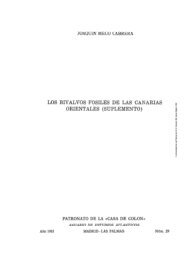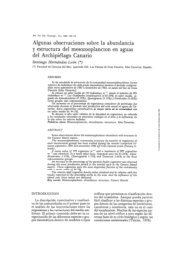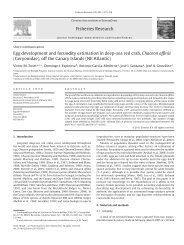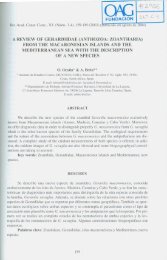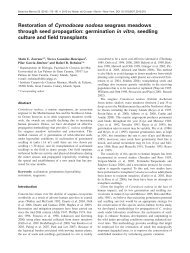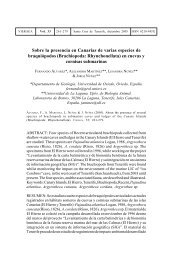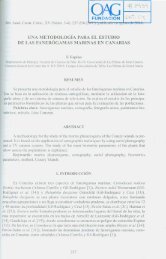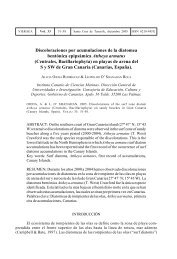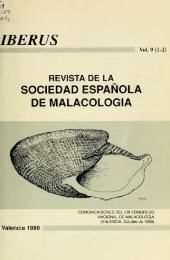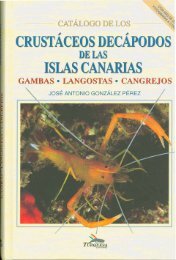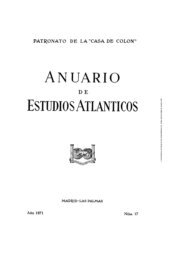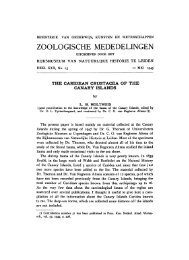of the madeira and selvagens archipelagos - redmic
of the madeira and selvagens archipelagos - redmic
of the madeira and selvagens archipelagos - redmic
You also want an ePaper? Increase the reach of your titles
YUMPU automatically turns print PDFs into web optimized ePapers that Google loves.
sempenhado igualmente um papel negativo na conservação<br />
de pelo menos uma espécie de morcego, Tadarida teniotis.<br />
Existem pelo menos três causas relacionadas com a acção<br />
do Homem para a redução das espécies de vertebrados<br />
em ilhas, e as três aplicam -se às ilhas da Madeira e Selvagens:<br />
1) a predação, 2) a introdução de espécies que não são<br />
nativas e 3) a degradação ou perda de habitat. Na Madeira<br />
e Selvagens, a introdução de mamíferos está relacionada,<br />
em muitos aspectos, com a predação e a degradação do<br />
habitat. Acredita -se que os vertebrados predadores, como<br />
os gatos, as ratazanas e os ratos, e os herbívoros, como as<br />
cabras e os coelhos, causaram os piores problemas ecológicos<br />
nestes ecossistemas insulares. Na verdade, a maior<br />
parte das espécies de vertebrados introduzidas na Madeira<br />
e <strong>selvagens</strong> estão incluídas na listagem das “100 espécies<br />
mais invasivas do mundo” (Lowe et al. 2001).<br />
Tendo isto em conta, os decisores políticos da Madeira<br />
implementaram, desde o início dos anos 90, um programa<br />
a longo termo para a restauração de muitos habitats terrestres<br />
dos arquipélagos da Madeira e Selvagens. Desde então,<br />
algumas espécies de vertebrados foram erradicadas,<br />
tais como os coelhos das Desertas e Selvagens, os ratos<br />
das Selvagens e as cabras da floresta Laurissilva da Madeira.<br />
Está actualmente a ser desenvolvido um subprojecto<br />
que levará também à erradicação destes vertebrados da<br />
ilha do Bugio, nas Desertas. Acredita -se que este programa,<br />
juntamente com outras medidas transversais, irá contribuir<br />
gr<strong>and</strong>emente para a salvaguarda da gr<strong>and</strong>e biodiversidade<br />
existente nos arquipélagos da Madeira e Selvagens.<br />
7. Agradecimentos<br />
Agradecemos ao Paulo Sousa pela informação valiosa<br />
que disponibilizou acerca da presença de Actinopterygii na<br />
Madeira e Selvagens.<br />
8. Referências bibliográficas | References<br />
Cabral, J., Almeida, J., Almeida, P., Dellinger, T., Ferr<strong>and</strong>, A., Oliveira,<br />
M., Palmeirim, J., Queiroz, A.I., Rogado, L. & Santos-Reis, M.<br />
(eds.) (2005) Livro Vermelho dos Vertebrados de Portugal Instituto<br />
da Conservação da Natureza. Lisboa.<br />
Cramp, S. (1998) The complete birds <strong>of</strong> <strong>the</strong> Western Palearctic (CD-<br />
-ROM). Oxford University Press, Oxford.<br />
Grant, P. (1998) Evolution on Isl<strong>and</strong>s. Oxford University Press. New<br />
York.<br />
Groombridge, B. (ed.) (1992) Global biodiversity: status <strong>of</strong> <strong>the</strong> earth<br />
living resources (A report compiled by <strong>the</strong> World Conservation<br />
Monitoring Centre). Chapman & Hall, London.<br />
Izquierdo, I., Martín, J.L., Zurita, N. & Arechavaleta, M. (2001) Lista<br />
de Especies Silvestres de Canarias. Hongos, Plantas y Animales.<br />
Consejería de Política Territorial y Medio Ambiente, Gobierno de<br />
Canarias, Santa Cruz de Tenerife.<br />
Keast, A. & Miller, S (1996) The origin <strong>and</strong> evolution <strong>of</strong> Pacific Isl<strong>and</strong>s<br />
Biotas, New Guinea to eastern Polynesia: patterns <strong>and</strong> processes.<br />
SPB Academic Publishing, Amsterdam.<br />
Lowe, S., Browne, M. & Boudgelas, S. (2001) 100 <strong>of</strong> <strong>the</strong> World’s<br />
Worst Invasive Alien Species. A selection from <strong>the</strong> Global Invasi-<br />
365<br />
There are at least three classical reasons why isl<strong>and</strong> species<br />
are reduced by human action, <strong>and</strong> <strong>the</strong>y all apply to <strong>the</strong><br />
<strong>archipelagos</strong> <strong>of</strong> Madeira <strong>and</strong> Selvagens: direct predation,<br />
<strong>the</strong> introduction <strong>of</strong> non -native species <strong>and</strong> habitat degradation<br />
or loss. In <strong>the</strong> context <strong>of</strong> <strong>the</strong> Madeira <strong>and</strong> Selvagens<br />
<strong>archipelagos</strong>, <strong>the</strong> introduction <strong>of</strong> mammals is in many ways<br />
linked with predation <strong>and</strong> habitat degradation. It is <strong>of</strong>ten noted<br />
that predators such as cats, rats <strong>and</strong> mice, <strong>and</strong> browsing<br />
animals such as goats <strong>and</strong> rabbits, have caused some<br />
<strong>of</strong> <strong>the</strong> worst problems to isl<strong>and</strong> ecosystems. Most <strong>of</strong> <strong>the</strong><br />
introduced species <strong>of</strong> vertebrates present in <strong>the</strong> <strong>archipelagos</strong><br />
<strong>of</strong> Madeira <strong>and</strong> Selvagens are listed in <strong>the</strong> “100 worst<br />
invasive species <strong>of</strong> <strong>the</strong> world” (Lowe et al. 2001).<br />
Bearing this in mind, <strong>the</strong> authorities have implemented,<br />
since <strong>the</strong> early nineties, a longterm programme for <strong>the</strong> restoration<br />
<strong>of</strong> many different terrestrial habitats in <strong>the</strong>se <strong>archipelagos</strong>.<br />
Since <strong>the</strong>n rabbits have been eradicated from<br />
Desertas <strong>and</strong> Selvagens, mice from <strong>the</strong> Selvagens <strong>and</strong> goats<br />
from <strong>the</strong> laurel forest <strong>of</strong> Madeira. At present, <strong>the</strong>re is an<br />
ongoing project that will hopefully lead to <strong>the</strong> eradication<br />
<strong>of</strong> <strong>the</strong>se three above -mentioned animals from <strong>the</strong> isl<strong>and</strong> <strong>of</strong><br />
Bugio (Desertas). It is believed that this programme, toge<strong>the</strong>r<br />
with o<strong>the</strong>r transversal measures, will strongly contribute<br />
to <strong>the</strong> safeguarding <strong>of</strong> <strong>the</strong> rich biodiversity <strong>of</strong> <strong>the</strong> Madeira<br />
<strong>and</strong> <strong>the</strong> Selvagens <strong>archipelagos</strong>.<br />
7. Acknowledgements<br />
We wish to thank Paulo Sousa who gave valuable information<br />
about <strong>the</strong> presence <strong>of</strong> Actinopterygii on Madeira.



